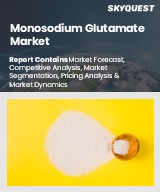
세계의 글루타민산 나트륨 시장 규모는 2023년에 52억 6,000만 달러로 평가되며, 예측 기간(2025-2032년)의 CAGR은6%로, 2024년 55억 달러에서 2032년에는 88억 달러로 성장할 전망입니다.
세계 글루탐산나트륨 시장은 비용 효율성과 풍미를 향상시키는 특성과 함께 가공식품 및 편의식품에 대한 수요 증가에 힘입어 강력한 성장세를 보이고 있습니다. 패스트푸드 체인 및 케이터링 서비스를 포함한 외식 산업은 맛을 개선하고 조리 과정을 간소화하기 위해 글루탐산나트륨을 사용하고 있습니다. 글루탐산나트륨의 인기는 아시아 요리에서도 점점 더 널리 받아들여지고 있습니다. 클린 라벨, 저염 옵션 등 보다 건강한 제형에 대한 관심은 고품질 식재료를 찾는 건강 지향적인 소비자들을 만족시키고 있습니다. 또한 AI, IoT, 블록체인과 같은 디지털 기술의 발전은 프로세스를 최적화하고, 풍미를 높이고, 낭비를 최소화하고, 공급망의 투명성을 보장함으로써 제조 환경을 변화시키고 있으며, 경쟁 시장에서 시장 상황을 유리하게 만들고 있습니다.
Global Monosodium Glutamate Market size was valued at USD 5.26 Billion in 2023 and is poised to grow from USD 5.5 Billion in 2024 to USD 8.8 Billion by 2032, growing at a CAGR of 6% in the forecast period (2025-2032).
The global monosodium glutamate market is witnessing robust growth, fueled by the increased demand for processed and convenient foods, alongside its cost-effectiveness and flavor-enhancing properties. Food service establishments, including fast food chains and catering services, utilize monosodium glutamate to enhance taste and streamline preparation processes. Its popularity is also rising with Asian cuisine, fostering broader acceptance. The focus on healthier formulations, such as clean-label and low-sodium options, caters to health-conscious consumers seeking quality ingredients. Moreover, advancements in digital technologies, including AI, IoT, and blockchain, are transforming the manufacturing landscape by optimizing processes, enhancing flavor, minimizing waste, and ensuring supply chain transparency, thereby positioning monosodium glutamate favorably in a competitive market.
Top-down and bottom-up approaches were used to estimate and validate the size of the Global Monosodium Glutamate market and to estimate the size of various other dependent submarkets. The research methodology used to estimate the market size includes the following details: The key players in the market were identified through secondary research, and their market shares in the respective regions were determined through primary and secondary research. This entire procedure includes the study of the annual and financial reports of the top market players and extensive interviews for key insights from industry leaders such as CEOs, VPs, directors, and marketing executives. All percentage shares split, and breakdowns were determined using secondary sources and verified through Primary sources. All possible parameters that affect the markets covered in this research study have been accounted for, viewed in extensive detail, verified through primary research, and analyzed to get the final quantitative and qualitative data.
Global Monosodium Glutamate Market Segments Analysis
The global monosodium glutamate market is segmented into form, application, distribution channel, and region. By form, the market is bifurcated into powder and granules. Depending on application, it is categorized into noodles, soups and broths, meat products, seasonings and dressings, and others. Based on distribution channel, it is bifurcated into B2B and B2C. Regionally, it is analyzed across North America, Europe, Asia-Pacific, Latin America, and the Middle East & Africa.
Driver of the Global Monosodium Glutamate Market
The rising global interest in diverse and sophisticated flavor profiles has rekindled the popularity of monosodium glutamate, or MSG, particularly in the culinary world. Recognized as the fifth fundamental taste, umami is embraced in gourmet dining and various culinary cultures. As consumers become more adventurous in their food choices, MSG is making a comeback in both packaged foods and restaurant menus. Additionally, the influence of cooking shows, food bloggers, and celebrity chefs plays a significant role in promoting the use of monosodium glutamate, encouraging a broader acceptance and integration of this flavor enhancer into everyday cooking and dining experiences.
Restraints in the Global Monosodium Glutamate Market
The global monosodium glutamate market faces significant challenges due to persistent misconceptions about its safety. Although a substantial portion of the scientific community recognizes the substance as safe for consumption in moderation, the lingering belief that it triggers negative health effects and allergic reactions influences consumer behavior. Consequently, numerous food brands and restaurants highlight their products as "No MSG" or "MSG Free," thus perpetuating the notion that monosodium glutamate is detrimental. This situation compels companies to allocate resources toward customer education and developing clean label strategies, both of which can be costly and time-intensive, further hindering market growth.
Market Trends of the Global Monosodium Glutamate Market
The Global Monosodium Glutamate market is experiencing a notable trend driven by the increasing demand for low-sodium food products as consumers become more health-conscious about salt intake. This shift is particularly visible in premium restaurants, hospital catering, elderly care meals, and wellness-oriented food brands that emphasize nutritional integrity without sacrificing flavor. As a result, monosodium glutamate is being strategically incorporated into heart-friendly and reduced-sodium product lines, providing a solution that balances taste enhancement with health benefits. This evolving consumer preference signals a growing acceptance of monosodium glutamate as a viable alternative to traditional salts in various culinary applications.